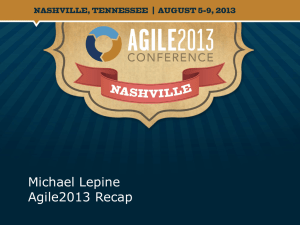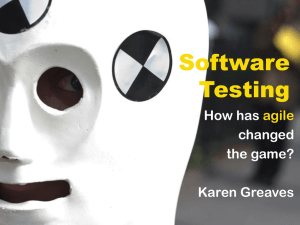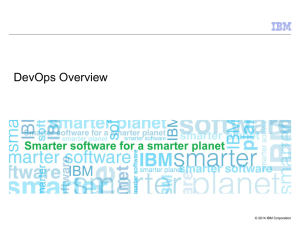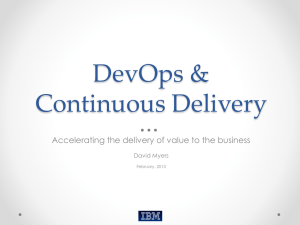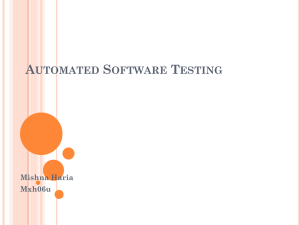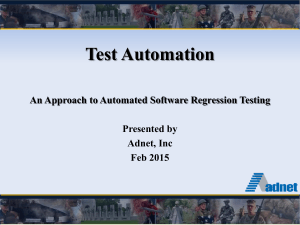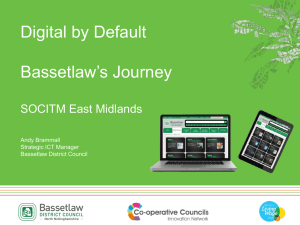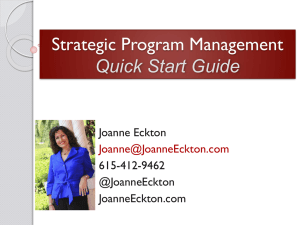DevOps - Maturity Model
advertisement
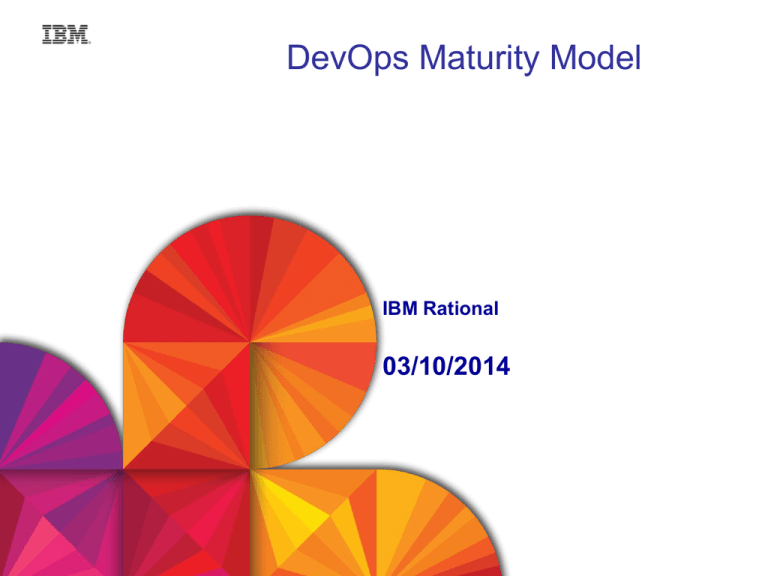
DevOps Maturity Model IBM Rational 03/10/2014 1 What Are Our Goals? • Ultimate goal is to continuously improve tools and process to produce a quality product with faster delivery to our customers. • Measuring the continuous improvement is important to show we are focusing in the areas that provide us the best ROI. • How do we plan to measure? – DevOps Maturity Model Self Assessment – DevOps Outcome Based Self Measurement • How often do we plan on doing the self assessments? – Current plan is once quarterly • What will be done with the measurements? – Identify Tools/Processes that can help improve DevOps Maturity – Continuous improvement measured through the metrics collected. – Will be shared with the executive teams 2 © 2013 IBM Corporation DevOps Principles and Values DevOps Maturity Model Self Assessment Iterative and frequent deployments using repeatable and reliable processes "Plan & Measure" Questions. 1. . 63. Continuously monitor and validate operational quality characteristics DevOps Maturity Model Define Define release release with with business business objectives objectives Measure Measure to to customer customer value value Improve Improve continuously continuously with with development development intelligence intelligence Test Test Continuously Continuously Manage Manage environments environments through through automation automation Provide Provide self-service self-service build, build, provision provision and and deploy deploy Automate Automate problem problem isolation isolation and and issue issue resolution resolution Optimize Optimize to to customer customer KPIs KPIs continuously continuously Plan Plan and and source source strategically strategically Dashboard Dashboard portfolio portfolio measures measures Manage Manage data data and and virtualize virtualize services services for for test test Deliver Deliver and and integrate integrate continuously continuously Standardize Standardize and and automate automate cross-enterprise cross-enterprise Automate Automate patterns-based patterns-based provision provision and and deploy deploy Optimize Optimize applications applications Use Use enterprise enterprise issue issue resolution resolution procedures procedures Link Link objectives objectives to to releases releases Centralize Centralize Requirements Requirements Management Management Link Link lifecycle lifecycle information information Deliver Deliver and and build build with with test test Centralize Centralize management management and and automate automate test test Plan Plan departmental departmental releases releases and and automate automate status status Monitor Monitor using using business business and and end end user user context context Automated Automated deployment deployment with with standard standard topologies topologies Centralize Centralize event event notification notification and and incident incident resolution resolution Plan Plan and and manage manage releases releases Standardize Standardize deployments deployments Monitor Monitor resources resources consistently consistently Collaborate Collaborate Dev/Ops Dev/Ops informally informally Measure Measure to to project project metrics metrics Document Document objectives objectives locally locally Manage Manage department department resources resources Manage Manage Lifecycle Lifecycle artifacts artifacts Schedule Schedule SCM SCM integrations integrations and and automated automated builds builds Test Test following following construction construction Develop and test business strategy requirements against a production-like system Amplify feedback loops STG DevOps Proof of Concept Investigation Customer Interaction Feedback Partially Achieved Content Download Hosted Environment RFE Fully Achieved Customer Interaction Service Management Connect Driver VM SCE Goals Continuous Feedback Continuous Test Driver VM Driver VM Outcome Based Metrics 1) Which of the following best describes the state of your code at the end of each iteration? * Ready for testing * Partially tested, ready for additional integration, performance, security, and/or other testing * Fully tested, documented, and ready for production delivery or GA release (modulo translation work or legal approvals) 2) How quickly can your team pivot (complete a feature in progress and start working on a newly-arrived, highpriority feature)? * 3 months or longer * less than 3 months * less than one month * less than one week Continuous Deployment Agile Development Continuous Integration Rational Focal Point Rational UrbanCode Rational Team Concert 3) How quickly are you able to change a line of code and deliver to customers as part of a fully-tested, non-fixpack release? * 12 months or longer * less than 6 months * less than 3 months * less than one month * less than one week * less than one day 4) What is the cost (in person-hours) of executing a full functional regression test? <enter value> 5) How long does it take for developers to find out that they have committed a source code change that breaks a critical function? * One week or longer * 1 to 7 days * 12 to 24 hours * 3 to 12 hours * 1 to 3 hours * less than one hour 6) Which of the following best describes the state of your deployment automation for the environments used for testing? * We have no deployment automation. Setting up our test environments is entirely manual. * We have some deployment automation, but manual intervention is typically required (for example, to provision machines, setup dependencies, or to complete the process). * We create fully-configured test environments from scratch and we reliably deploy into those environments without manual intervention. * We create fully-configured production-congruent environments from scratch and we reliably deploy into those environments without manual intervention. 3 Continuous Build Task WI, Change Record WI Jazz SCM Jazz Build Engine (JBE) Security (AppScan) Image Catalog Development VM Web Browser RTC Eclipse Client RTC Web Client Builder VM RTC Eclipse Client UrbanCode Deploy? RTC Build Engine Client Build Resources AppScan Compilers Compile Pool Resource RTC Build Engine Agent Test Environment Driver Images Debug Environment Test Resources RTC Web Client RTC Eclipse Client Compilers AppScan Compile Pool Resource Driver Images Web Browser Test Resources RTC Web Client Debug Environment RTC Eclipse Client RTC Build Client (JBE) Focal Point Client © 2013 IBM Corporation Where do you start? DevOps improvements adoption Step 3 Step 2 Step 1 Assess and define outcomes & supporting practices to drive strategy and roll-out Determine Activities What am I trying to achieve? • Think through business-level drivers for improvement • Define measurable goals for your organizational investment • Look across silos and include key Dev and Ops stakeholders Where am I currently? What are my priorities ? • • • • Objective Business Goal Determination What do you measure and currently achieve What don’t you measure, but should to improve What practices are difficult, incubating, well scaled How do your team members agree with these findings Current Practice Assessment • Start where you are today and where your improvement goals • Consider changes to People, Practices, Technology • Prioritize change using goals, complexities and dependencies Define Define release release with with business business objectives objectives Measure Measure to to customer customer value value Improve Improve continuously continuously with with development development intelligence intelligence Test Test Continuously Continuously Manage Manage environments environments through through automation automation Provide Provide self-service self-service build, build, provision provision and and deploy deploy Plan Plan and and source source strategically strategically Dashboard Dashboard portfolio portfolio measures measures Manage Manage data data and and virtualize virtualize services services for for test test Deliver Deliver and and integrate integrate continuously continuously Standardize Standardize and and automate automate cross-enterprise cross-enterprise Automate Automate patterns-based patterns-based provision provision and and deploy deploy Optimize Optimize applications applications Use Use enterprise enterprise issue issue resolution resolution procedures procedures Link Link objectives objectives to to releases releases Centralize Centralize Requirements Requirements Link Link lifecycle lifecycle information information Deliver Deliver and and build build with with test test Centralize Centralize management management and and automate automate test test Plan Plan departmental departmental releases releases and and automate automate status status Monitor Monitor using using business business and and end end user user context context Automated Automated deployment deployment with with standard standard topologies topologies Centralize Centralize event event notification notification and and incident incident resolution resolution Plan Plan and and manage manage releases releases Standardize Standardize deployments deployments Monitor Monitor resources resources consistently consistently Collaborate Collaborate Dev/Ops Dev/Ops informally informally Management Management Measure Measure to to project project metrics metrics Document Document objectives objectives locally locally Manage Manage department department resources resources Manage Manage Lifecycle Lifecycle artifacts artifacts Schedule Schedule SCM SCM integrations integrations and and automated automated builds builds Test Test following following construction construction Automate Automate problem problem isolation isolation and and issue issue resolution resolution Optimize Optimize to to customer customer KPIs KPIs continuously continuously Objective & Prioritized Capabilities Step 4 Fully Achieved 4 How should my practices improve? • • • • Understand your appetite for cross functional change Target improvements which get the best bang for the buck Roadmap and agree on an actionable plan Use measurable milestones that include early wins Roadmap © 2013 IBM Corporation Partially Achieved Goals Outcome Based Metrics 1) Which of the following best describes the state of your code at the end of each iteration? * Ready for testing * Partially tested, ready for additional integration, performance, security, and/or other testing * Fully tested, documented, and ready for production delivery or GA release (modulo translation work or legal approvals) 2) How quickly can your team pivot (complete a feature in progress and start working on a newly-arrived, high-priority feature)? * 3 months or longer * less than 3 months * less than one month * less than one week 3) How quickly are you able to change a line of code and deliver to customers as part of a fully-tested, non-fixpack release? * 12 months or longer * less than 6 months * less than 3 months * less than one month * less than one week * less than one day 4) What is the cost (in person-hours) of executing a full functional regression test? <enter value> 5) How long does it take for developers to find out that they have committed a source code change that breaks a critical function? * One week or longer * 1 to 7 days * 12 to 24 hours * 3 to 12 hours * 1 to 3 hours * less than one hour 6) Which of the following best describes the state of your deployment automation for the environments used for testing? * We have no deployment automation. Setting up our test environments is entirely manual. * We have some deployment automation, but manual intervention is typically required (for example, to provision machines, setup dependencies, or to complete the process). * We create fully-configured test environments from scratch and we reliably deploy into those environments without manual intervention. * We create fully-configured production-congruent environments from scratch and we reliably deploy into those environments without manual intervention. 5 © 2013 IBM Corporation Outcome Based Metrics 7) (If your product is SaaS) Which of the following best describes the state of your deployment automation for your staging and production environments? * We have no deployment automation. Setting up our staging and production environments is entirely manual. * We have some deployment automation, but manual intervention is typically required (for example, to provision machines, setup dependencies, or to complete the process). * We create fully configured staging and production environments from scratch and we reliably deploy into those environments without manual intervention. 8) (If your product is SaaS) Are you able to make business decisions based on data provided by infrastructure, application, and customer experience monitoring? * yes * no 9) (If your product is SaaS) How much downtime is generally required to deploy a new version into production? * 4 hours or longer * 1-4 hours * less than 1 hour * No downtime is needed 10) (If your product is SaaS) How often do problems occur when deploying a new version into production? * Problems always occur * Problems occur about 50% of the time * Problems occur about 25% of the time * Problems occur about 10% of the time * Problems are rare 6 © 2013 IBM Corporation Initial Rollout 7 Project Contacts DevOps Overview & Maturity Model Self Assessment Analyze Results Ice Castle Marla Berg, John Beveridge, Lafonda Richburg 01/30/2014 03/07/2014 03/21/2014 Platform Resource Scheduler Anumpa, Jason Adelman, Shen Wu. 01/30/2014 03/06/2014 03/21/2014 IBM Cloud OpenStack Platform Christine Grev, Gary Palmersheim 01/30/2014 03/06/2014 03/21/2014 GPFS Bonnie Pulver, Lyle Gayne, Steve Duersch, Yuri L Volobuev 02/19/2014 02/21/2014 03/07/2014 Pinehurst Sue Townsend 01/30/2014 Power FW Atit 02/19/2014 AIX Atit 01/30/2014 PowerVC (Thomas) Platform LSF (Akthar) Platform Symphony (Akthar) MCP (Frye) PowerKVM (Frye) Power Linux? (Frye) Roadmap for Goals © 2013 IBM Corporation Sample Results DevOps Maturity Model Self Assessment Results Outcome Based Metrics 8 © 2013 IBM Corporation Sample Details Plan & Measure Reliable 9 © 2013 IBM Corporation Sample Details Develop & Test Practiced 10 © 2013 IBM Corporation Sample Details Release & Deploy Practiced 11 © 2013 IBM Corporation Sample Details Monitor & Optimize Practiced 12 © 2013 IBM Corporation DevOps Outcome Metrics DevOp Outcome Metrics Sample1 Sample2 1. State of code at end of iteration Partially Tested Partially tested 2. How quick pivot to new high priority Less than 1 month Less than 3 months 3. How long from LOC to tested release Less than 1 month Less than 3 months 4. Person Hours of full functional regression 280 hours (7 PW) (if 1-2 weeks, what PW)? 5. Dev time to knowing critical function broken 1-3 hours 12-24 hours 6. State of deployment automation 13 We create fully configured test environments from scratch and we reliably deploy into those environments without manual intervention We have some deployment automation but manual intervention is typically required 7. If SAAS, Deployment automation for staging N/A N/A 8. If SAAS, decisions based on monitoring? N/A N/A 9. If SAAS, downtime required to deploy prod N/A N/A 10. If SAAS, problems on prod deployments N/A N/A © 2013 IBM Corporation Plan / Measure Development / Test Scaled Define release with business objectives Measure to customer value Improve continuously with development intelligence Test Continuously Manage environments through automation Provide self-service build, provision and deploy Automate problem isolation and issue resolution Optimize to customer KPIs continuously Reliable Plan and source strategically Dashboard portfolio measures Manage data and virtualize services for test Deliver and integrate continuously Standardize and automate cross-enterprise Automate patterns-based provision and deploy Optimize applications Use enterprise issue resolution procedures Repeatable Link objectives to releases Centralize Requirements Management Measure to project metrics Automated test environment deployment Run unattended test automation / regression Plan departmental releases and automate status Automated deployment with standard topologies Monitor using business and end user context Practiced Sample Maturity Model Assessment Document objectives locally Manage department resources Schedule SCM integrations and automated builds Test following construction Plan and manage releases Standardize deployments Fully Achieved 14 14 Release / Deploy Partially Achieved Monitor / Optimize Centralize event notification and incident resolution Monitor resources consistently Collaborate Dev/Ops informally Goal © 2013 IBM Corporation Define release with business objectives Measure to customer value Improve continuously with development intelligence Test Continuously Plan and source strategically Dashboard portfolio measures Link objectives to releases Centralize Requirements Management Measure to project metrics Document objectives locally Manage department resources 15 Monitor / Optimize Manage environments through automation Provide self-service build, provision and deploy Manage data and virtualize services for test Deliver and integrate continuously Automated test environment deployment Run unattended test automation / regression Plan departmental releases and automate status Automated deployment with standard topologies Schedule SCM integrations and automated builds Test following construction Plan and across manage releases Focus Standardize deployments Fully Achieved 15 Release / Deploy GOALS: Standardize and automate Where is the cross-enterprise Automate patterns-based best provision and result? deploy Focus up Reliable Development / Test Repeatable Plan / Measure Practiced Scaled Sample Maturity Model Assessment Partially Achieved Automate problem isolation and issue resolution Optimize to customer KPIs continuously Optimize applications Use enterprise issue resolution procedures Monitor using business and end user context Centralize event notification and incident resolution Monitor resources consistently Collaborate Dev/Ops informally Goal © 2013 IBM Corporation Goal Discussion: Planning for Initiative #1 Pain Point 16 Improvement Value Effort Required Priority Next Step © 2013 IBM Corporation DevOps Proof of Concept Investigation Customer Interaction Customer Interaction Service Management Connect Feedback Content Download Hosted Environment RFE Driver VM SCE Continuous Feedback Continuous Test Driver VM Driver VM Continuous Deployment Agile Development Continuous Integration Continuous Build Rational Focal Point Rational UrbanCode Rational Team Concert Task WI, Change Record WI Jazz SCM Jazz Build Engine (JBE) Security (AppScan) Image Catalog Development VM Web Browser RTC Eclipse Client RTC Web Client Builder VM RTC Eclipse Client UrbanCode Deploy? RTC Build Engine Client Build Resources AppScan Compilers Compile Pool Resource RTC Build Engine Agent 17 Test Environment Driver Images Debug Environment Test Resources RTC Web Client RTC Eclipse Client Compilers AppScan Compile Pool Resource Driver Images Web Browser Test Resources RTC Web Client Debug Environment RTC Eclipse Client RTC Build Client (JBE) © 2013 IBM Corporation Focal Point Client 18 Plan / Measure Development / Test Scaled Define release with business objectives Measure to customer value Improve continuously with development intelligence Test Continuously Manage environments through automation Provide self-service build, provision and deploy Automate problem isolation and issue resolution Optimize to customer KPIs continuously Reliable Plan and source strategically Dashboard portfolio measures Manage data and virtualize services for test Deliver and integrate continuously Standardize and automate cross-enterprise Automate patterns-based provision and deploy Optimize applications Use enterprise issue resolution procedures Repeatable Link objectives to releases Centralize Requirements Management Measure to project metrics Link lifecycle information Deliver and build with test Centralize management and automate test Plan departmental releases and automate status Automated deployment with standard topologies Monitor using business and end user context Centralize event notification and incident resolution Practiced Introduction to Practice Based Maturity Model Release / Deploy Monitor / Optimize Document objectives locally Manage department resources Manage Lifecycle artifacts Schedule SCM integrations and automated builds Test following construction Plan and manage releases Standardize deployments Monitor resources consistently Collaborate Dev/Ops informally © 2013 IBM Corporation Maturity Levels Defined Specific maturity levels are defined by how well an organization can perform practices. The levels look at consistency, standardization, usage models, defined practices, mentor team or center of excellence, automation, continuous improvement and organizational or technical change management. Practiced Some teams exercise activities associated with the practice, inconsistently. No enterprise standards defined. Automation may be in place but without consistent usage models. Repeatable (Consistent) Enterprise standards for practice are defined. Some teams exercise activities associated with the practice and follow the standards. No core team or COE to assist with practice adoption. Automation, if used, follows enterprise standards. Reliable Mechanisms exist to assist adoption and ensure that standards are being followed. Core team of mentors available to assist in adoption. Scaled 19 Institutionalized adoption across the enterprise. COE is a matured and integral part of continuous improvement and enablement. Practices are mainstreamed across the enterprise. Feedback process in place to improve the standards. © 2013 IBM Corporation Plan/Measure At the practiced level, organizations capture business cases or goals in documents for each project to define scope within the strategy but resourcing for projects are managed at the department level. Once projects are executed change decisions and scope are managed within the context of the project or program to achieve goals within budget/time. As organizations mature business needs are documented within the context of the enterprise and measured to meet customer value metrics. Those needs are then prioritized and aligned to releases and linked to program or project requirements. Project change decisions and scope are managed at the portfolio level. 20 © 2013 IBM Corporation Development/Test At the practiced level, project and program teams produce multiple software development lifecycle products in the form of documents, spreadsheets to explain their requirements, design, test plans. Code changes and application level builds are performed on a formal, periodic schedule to ensure sufficient resources are available to overcome challenges. Testing, except for unit level, is performed following a formal delivery of the application build to the QA team after most if not all construction is completed. As organizations mature, software development lifecycle information is linked at the object level to improve collaboration within the context of specific tasks and information. This provides the basis for development intelligence used to assess the impact of processor technology improvements, continuously. A centralized testing organization and service provides support across application/projects that can continuously test regressions and higher level automated tests provided infrastructure and application deployment can also support. Software delivery, integration and build with code scans/unit testing are performed routinely and on a continuous basis for individual developers, teams, applications and products. . 21 © 2013 IBM Corporation Release/Deploy At the practiced level, releases are planned annually for new features and maintenance teams. Critical repairs and off-cycle releases emerge as needed. All are managed in a spreadsheet updated through face-to-face meetings. Impact analysis of change is performed manually as events occur. Application deployments and middleware configurations are performed consistently across departments using manual or manually staged and initiated scripts. Infrastructure and middleware are provisioned similarly. As organization mature, releases are managed centrally in a collaborated environment that leverages automation to maintain the status of individual applications. deployments and middleware configurations are automated then move to a self-service providing individual developers, teams, testers and deployment managers with a capability to build, provision, deploy, test and promote, continuously . Infrastructure and middleware provisioning evolves to an automated then self-service capability similar to application deployment. Operations engineers move to changing automation code and re-deploying over manual or scripted changes to existing environments. . 22 © 2013 IBM Corporation Monitor/Optimize At the practiced level, deployed resources are monitored and events or issues are addressed as they occur without context of the affected business application. Dev and Ops coordination is usually informal and event driven. Feedback of user experience with business applications is achieved through formalized defect programs. As organizations mature, monitoring is performed within the context of business applications and optimization begins in QA environments to improve stability, availability and overall performance. Customer experience is monitored to optimize experiences within business applications. Optimization to customer KPIs is part of the continuous improvement program. 23 © 2013 IBM Corporation Sample: Practice based maturity model: Maturity Goals for an Initiative Scaled Define release with business objectives Measure to customer value Improve continuously with development intelligence Test Continuously Manage environments through automation Provide self-service build, provision and deploy Automate problem isolation and issue resolution Optimize to customer KPIs continuously Plan and source strategically Dashboard portfolio measures Manage data and virtualize services for test Deliver and integrate continuously Standardize and automate cross-enterprise Automate patterns-based provision and deploy Optimize applications Use enterprise issue resolution procedures Link objectives to releases Centralize Requirements Management Measure to project metrics Link lifecycle information Deliver and build with test Centralize management and automate test Plan departmental releases and automate status Automated deployment with standard topologies Monitor using business and end user context Document objectives locally Manage department resources Manage Lifecycle artifacts Schedule SCM integrations and automated builds Test following construction Plan and manage releases Standardize deployments Fully Achieved 24 Monitor / Optimize Reliable Release / Deploy Repeatable Development / Test Practiced Plan / Measure Partially Achieved Centralize event notification and incident resolution Monitor resources consistently Collaborate Dev/Ops informally Goals © 2013 IBM Corporation
